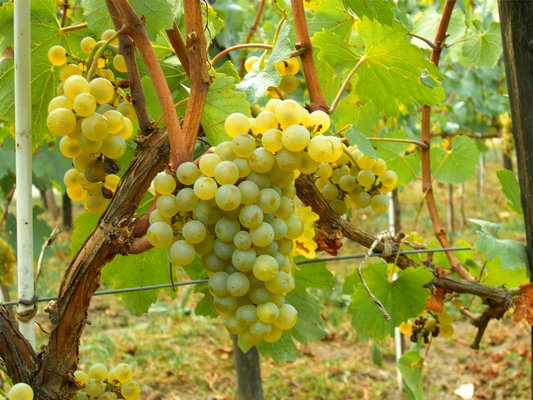
As a wine columnist, this time of the year I’m inundated with PR pitches about pink wines from every part of the globe.
While this is a far better inundation than Noah’s Flood, and though I will get around to writing about summer rosés, I’d like to make a case, instead, for Long Island chardonnay as your go-to, goes-with-everything summer beverage. Wait, you’re tired of chardonnay? Let me explain why you should give it a chance.
Chardonnay is the world’s most-planted white wine grape, simply because it grows easily, and well, in most places that can facilitate grape vines. In its most widely distributed iterations, it, like merlot, has been bowdlerized, sanitized, sweetened and oak-chipped to death. When I say “bowdlerized,” I mean that, like the versions of Shakespeare that high school students used to read, all the sex has been taken out of it. Where’s the passion? Where’s the zing? There are vast numbers of people who ask for “ABC”—anything but chardonnay—because they are appalled by the neutered, caramel-custard version of this varietal wine and seek something more lively.
“The popularity of the varietal caused a production frenzy that put a good amount of mediocre wines in the market,” explained Charles Massoud, co-owner of Paumanok Vineyards in Aquebogue, “creating this backlash.”
The chardonnay grape is a cross between the pinot noir and gouais blanc. In medieval Burgundy, where monasteries owned the sunny slopes best suited to ripening grapes, monks selected the best clones of pinot noir. They disdained the more prolific gouais—derived from the old French adjective “gou,” meaning “peasant,” coarse and stupid—grown by common people on heavier lowland soils. I challenge you to say “gouais” without making a face. If you think that’s bad, in 1395, Philip the Bold outlawed the planting of Gamay in Burgundy, calling it a “very bad and disloyal plant.”
Vineyards in Burgundy used to be planted “en foule,” or “in a crowd,” rather than in rows, so by close proximity, noble pinot romanced crude gouais and produced the happy baby chardonnay. Today there are 34 clones, or variations, of chardonnay grapes, some more noble than others. The best have proved to be singularly successful all over Burgundy and into Champagne, where it is now officially the only white grape permitted.
But even in France, chardonnay took on distinctive styles depending on where the grape was grown. In the cooler, northernmost region of Chablis, it has always been lean, tight and vibrant. On the warmer “Côte-d’Or,” or Gold Coast, of Montrachet, it is richer and, at the most prominent properties that can afford them, it is aged in new barrels, taking on the smoky, vanilla-infused aromas of air-dried oak.
These two styles of white Burgundy set the benchmark for chardonnay worldwide. Oaked or not, their quality is driven by their vibrant natural acidity.
California chardonnay, post-Prohibition, was modeled on the riper Burgundian style and even dared usurp the throne of Burgundy when, in 1976, Napa’s Chateau Montelena Winery bested grand cru Montrachet and Meursault at the famous “Judgment of Paris” blind tasting.
In 1992, a Sonoma winemaking accident added a new style of chardonnay and profoundly affected consumer expectations for the variety. Sonoma grower Jess Jackson decided to make wine from his grapes instead of selling them. But his grapes were overly sweet that year, and the wine failed to ferment completely. Faced with a warehouse of sweet, high-alcohol chardonnay, he oaked it and marketed it as something special, “Vintner’s Reserve” chardonnay, with an embossed label and an approachable price. When it won a Double Platinum Award in the 1993 American Wine Competition, other California chardonnay producers followed suit with equally supercharged, sweet, oaky and alcoholic chards. Today, Kendall Jackson dedicates more than 11,000 acres to this wine alone.
Because this style of chardonnay looked sophisticated, but appealed to the American sweet tooth, it soon influenced how chardonnay is made all over the world—including Burgundy.
If your idea of chardonnay is the “KJ” style, and you have joined the ABC backlash, I suggest you try Long Island chardonnay. It’s different. Our summer heat is less intense; our climate brings energy, balance and nuanced fruit aromas to our local chardonnay. Still, there are stylistic variations. “Early Wine” from Macari Vineyards in Mattituck is a chard with gushers of citrusy flavor. From The Lenz Winery’s “Gold,” “Silver” and “White” label chards in Peconic, you can choose your favorite depth of fruit and oak. At Paumanok Vineyards in Aquebogue, winemaker Kareem Massoud has added a “minimalist” chardonnay—uninoculated, unfiltered and unfined—to its classic, barrel-fermented and “Festival” chardonnay offerings.
Cult chardonnay from Long Island? Try it.